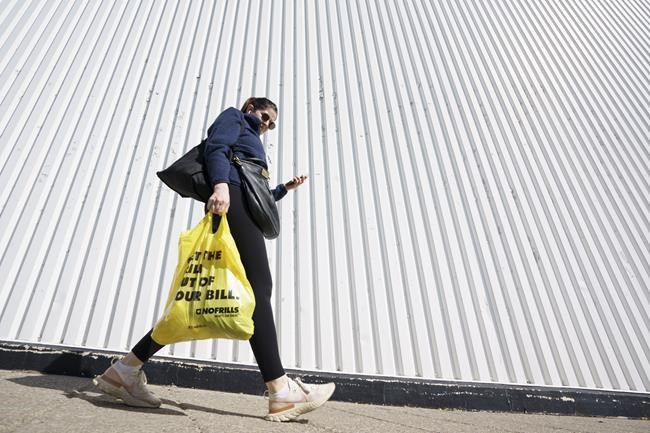High inflation has been an issue in Canada, impacting the cost of living and leaving many Canadians struggling. The most vulnerable Canadians, such as those on fixed incomes, are being hit the hardest. The Bank of Canada has implemented measures to counter inflation, such as low interest rates and quantitative easing, but these have not been enough to offset inflationary pressures. Prices for goods and services have been rising, and the cost of living has become increasingly unaffordable for many Canadians. This has led to an increase in poverty and inequality, with those who are already struggling the most feeling the effects the most.
OTTAWA – Inflation has sapped the purchasing power of many Canadians, but the experience of rapidly rising prices has been far from uniform.
While the inflation rate shows how quickly prices are rising, other factors such as income and consumption patterns can make it harder or easier for people to deal with.
Here’s a look at how high inflation is right now, who’s feeling the pinch, and when Canadians can expect inflation to ease.
How high is the inflation?
After 8.1 percent in the summer, Canada’s annual inflation rate has slowed noticeably in recent months. In December, the annual inflation rate was 6.3 percent.
While still much higher than the Bank of Canada’s 2 percent target, recent monthly trends suggest inflation is nearing target.
But even as inflation slows, food prices in particular have been a pain point for many Canadians. In December, food prices were 11 percent higher than a year ago.
Have wages kept pace with the cost of living?
Wages are rising but have not kept pace with inflation. In December, average hourly wages increased by 5.1 percent compared to the previous year.
Brendan Bernard, a senior economist at hiring website Indeed, says Canadians’ real wages (the amount earned after accounting for inflation) have fallen by about 1 percent on average over this period.
But some have seen their wages rise more than others, making it easier for those who have received a raise to cope with the rising cost of living.
Trevor Tombe, an economics professor at the University of Calgary, said workers who landed a new job or took up a job opportunity with their employer are likely to have seen a larger pay rise than others.
Workers cannot always negotiate wages to reflect increases in the cost of living. For example, unionized workers negotiate contracts at fixed times.
“It may take some time for the current surge in inflation to be offset by higher wages for individuals,” Tombe said.
Who has been hit hardest by inflation?
While most Canadians have likely experienced sticker shock at the grocery store or elsewhere, not everyone is equally tense.
“Inflation is not just a single, homogeneous experience that everyone goes through,” Tombe said.
Depending on what people buy, the amount they need to sustain their consumption levels and lifestyle can be higher or lower than the headline inflation rate.
Tombe said families with children are particularly hard hit by inflation because a larger part of their budget is spent on food and fuel, two categories that have seen sharp price increases. According to his calculations based on October 2022, a family with children spent about $65 more per month on average than one without children.
“Price increases will weigh more heavily on lower-income households because they save less than higher-income households,” he said.
With a smaller savings buffer, lower-income Canadians find it harder to meet the costs of rising bills. Meanwhile, higher earners can absorb additional costs by reducing their savings.
Statistics Canada data show that average net household savings have fallen across all income brackets. But the trend is more alarming for households in the bottom 40 percent because they tend to spend more than they earn in income.
For example, in the third quarter of 2022, households in the bottom 20 percent of earners spent about $7,400 more than they earned. In the third quarter of 2021 it was $6,550.
Meanwhile, the top 20% saved, on average, about $14,200 in Q3 2022, compared to $16,900.
How far have the Canadians fallen behind?
With prices rising at the fastest pace in decades and the federal Liberals in the hot seat on cost-of-living issues, inflation has featured prominently in the House of Commons.
Federal Conservatives have particularly focused on affordability, urging the government to rein in spending.
“Canadians are worse off than ever,” Conservative MP and financial critic Jasraj Singh Hallan said Jan. 31.
Recent polls suggest that Conservatives are actually tapping into many Canadians’ feelings about the state of the economy.
But the recent surge in inflation hasn’t pushed Canadians back as far as some might think.
According to Tombe, purchasing power has dropped to 2019 levels, meaning a dollar can buy the same amount of goods and services today as a dollar could buy in 2019.
“It’s certainly wrong that Canadians have never been worse off,” said Tombe.
“Inflation has only turned the clock back a few years in terms of the average purchasing power of people’s wages.”
How do Canadians say they are doing?
A new poll shows most Canadians feel their financial situation is about the same as it was a year ago.
According to a Leger survey commissioned by the Association for Canadians Studies, 34 percent of Canadian households say their financial situation has worsened in the past year.
Meanwhile, 58 percent of respondents say their financial situation has remained relatively unchanged and nine percent say it has improved.
However, the percentage of Canadians who say they are worse off is higher among low-income earners.
According to the survey, 42 percent of those earning less than $40,000 say their household’s overall financial situation is worse.
The online survey was completed by 1,554 Canadians between January 23 and 25 and cannot be subject to a margin of error because online surveys are not considered true random samples.
When will inflation go down?
Barring any unexpected global events, most economists expect inflation to slow further this year.
The Bank of Canada forecasts that the annual inflation rate will reach 3 percent by mid-year and fall back to 2 percent in 2024.
Tombe said inflation still appears to be high as the rate is calculated on an annual basis.
The recent fall in prices, attributed to lower energy prices and loosening of supply chains, is likely to be reflected in the annual inflation rate in the coming months.
“The worst may be behind us,” said Tombe.
This report from The Canadian Press was first published on February 8, 2023.
Nojoud Al Mallees, The Canadian Press
Don’t miss interesting posts on Famousbio









